Installations
We host Installations from our community and guest artists alike.
Our modular space provides a wide range of possibilities for artists and encourages them to share their work in a dynamic and innovative way. With immersive projection, lighting, and sound, as well as motion capture and VR, the Movement Lab is well equipped to host multimedia arts installations. Our open space is also the perfect place for people to gather to view work-in-progress showings or have discussions exploring topics around movement and technology. Please contact us if you are interested in creating such an event and check out our past installations below.
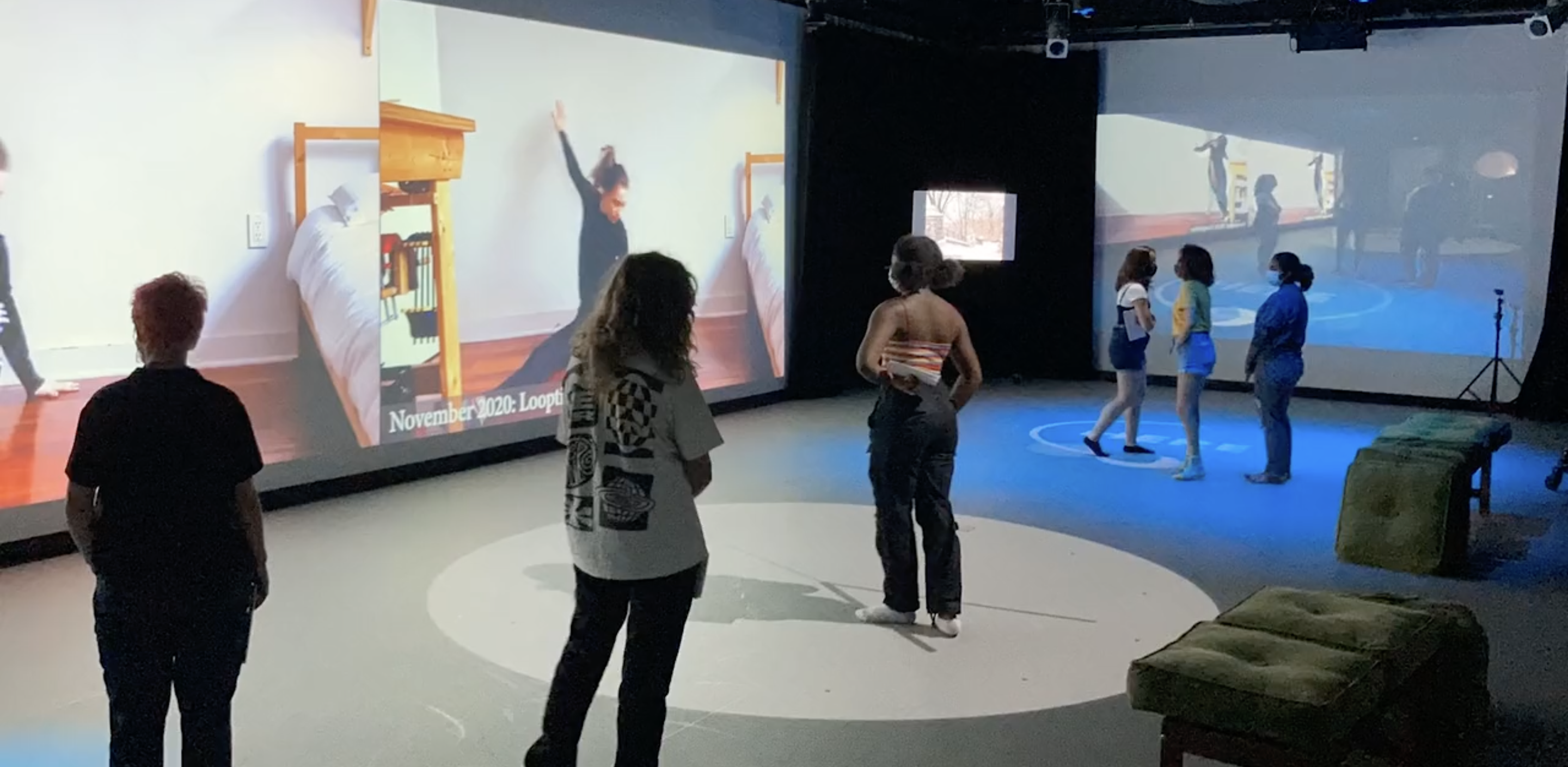
Upcoming Installations
Monday-Friday, March 6-10th 2:30-7:00 pm
Nami Weatherby brings their research as an Athena Center for Leadership Fellow to the Movement Lab to create a sound installation accompanied by projection mapping technology illuminating the strikingly networked origins and effects of nuclear wastelanding, excavation, and dispossession in different parts of the world. Nami explores these interconnections through individual people's and community’s stories, through oral historiographies, music, and other forms of storytelling.
Monday-Friday, March 20-24th 2:30-7:00 pm
COMMIT! is an interactive performance installation. Artist in Residence, Kate Ladenheim, falls repeatedly, while gathering audience feedback about whether her falls look committed enough. She then works to respond to that feedback, editing her falls to find the most committed expression. Throughout the performance, she uses motion capture as an attempt to correlate the mathematical positioning of her body to exemplary performances of commitment. The motion capture data also feeds into a real-time projected visual. As the performer falls and her exhaustion increases, the projected bodies become increasingly glitchy and distorted. This highlights the disparity between performance efforts towards maintaining excellence even amidst exhaustion and repetition, and the actual effects this has on the body.
Monday-Friday, April 3-7th 2:30-7:00 pm
Grace Li’s installation focuses on their experience growing up as a first-generation Chinese American daughter to two Chinese immigrant parents in Nashua, New Hampshire. Incorporating scans of the family archive, childhood videos, and their own film photography, the installation explores themes of growing up, the unreliability of memory, and family history.
Monday-Friday, April 17-21st 2:30-7:00 pm
During their residency at the Movement Lab, Christina Duan has explored celebration through tradition and heritage. Focusing primarily on the art of lion dance, Duan’s installation uses projection, sound, and videography to explore the importance of lion dance and move beyond the external, public-facing aesthetic to illuminate what it means to be a lion dancer.
Monday-Friday, April 24-28th 2:30-7:00 pm
During Chunming Zheng’s Movement Lab residency, they have combined documentary and VR technology. Chunming’s installation focuses on the living experience of vision-impaired people, featuring their own life story and oral history interview clips. The VR experience presented is designed to reproduce the world through Chunming’s eyes and allow the audience to experience life with limited visions.
Monday-Friday, May 1-5th 2:30-7:00 pm
Minne Atairu’s interactive and immersive installation utilizes algorithms, game engines, and virtual reality to investigate themes related to repatriation and post-repatriation practices in museums. During Minne’s time at Barnard's Movement Lab, they have imagined and built a hybrid environment to simulate futuristic structures of repatriation and new ways of interacting with repatriated collections.
Past Installations
Movement Lab Artist-in-Residence, new media artist, and creative technologist LaJuné McMillian presents The Black Movement Library Portrait Series. This installation consists of “Movement Portraits,” or 2D video representations of peoples’ movements created using perception neuron motion-capture suits, some of which were filmed in the Movement Lab. Black Movement Library is an archival project launched by McMillian in 2018 as an online database of motion capture data from Black performers and Black character base models, who are currently misrepresented and underrepresented in existing online databases.
LaJuné's "The Black Movement Library Portrait Series" Installation will be open Monday through Friday 12:00pm-5:00pm from October 4th until October 8th, 2021. Please stop by!
Bio:

LaJuné is a Multidisciplinary Artist, and Educator creating art that integrates performance, extended reality, and physical computing to question our current forms of communication. They are passionate about discovering, learning, manifesting, and stewarding spaces for liberated Black Realities and the Black Imagination. LaJune believes in making by diving into, navigating, critiquing, and breaking systems and technologies that uphold systemic injustices to decommodify our bodies, undo our indoctrination, and make room for different ways of being.
LaJuné has had the opportunity to show and speak about their work at Pioneer Works, National Sawdust, Leaders in Software and Art, Creative Tech Week, and Art & Code's Weird Reality. LaJuné was previously the Director of Skating at Figure Skating in Harlem, where they integrated STEAM and Figure Skating to teach girls of color about movement and technology. They have continued their research on Blackness, movement, and technology during residencies and fellowships at the Jerome Hill Artist Fellowship, Eyebeam, Pioneer Works, Barbarian Group, and Barnard College.
Cover Image: LaJuné McMillian: ‘Black Movement Project’, 2019 featuring dancer Nala Duma // Copyright LaJuné McMillian
Come to the lab for an installation of breath and motion activated robotic wings from Kate Ladenheim and Amy LaVier's work, Babyface, an interactive machine-augmented solo responding to feminized tropes around innocence, servitude, cuteness and spectacle. The “cyborg” performer is outfitted with a pair of robotic angel wings that simultaneously create an effect of grandeur and awe, and a rigid, limiting characterization that becomes eerily burdensome over the course of the performance. This tension between aspiration and limitation fuels this work, and directly parallels the ways that women and machines are talked about, treated, and — in the case of machines — designed to look and behave.
The Babyface Interactive Wings Installation will be open Monday through Friday 12:00pm-5:00pm from November 8th until November 12th, 2021. Corresponding with our monthly MeMoSa on November 11th, where Kate and Amy will perform and welcome feedback on Babyface and on the experiences of anyone who has tried out the installed wings throughout the week, so make sure to stop by!
About The Artists:
Babyface is a collaboration between interdisciplinary artist Kate Ladenheim and the Robotics, Automation, and Dance (RAD) Lab. The RAD Lab engages in interdisciplinary research bridging the areas of robotics, high-level control, movement representation, Human-Robot Interaction, and dance. This collaboration involves a collective of artists, engineers, dancers, and scientists using movement, design and machinery to create performance.
Ladenheim, as an independent artist, makes work that explores the interaction of bodies, media, and digital interfaces. She leans heavily into stereotype and archetype, embodying them through gesture, body language & spatial arrangement as well as highly designed scenic environments. She uses her work to demonstrate the ways that feminine bodies are disproportionately affected by technology and social pressure.
LaViers, as director of the RAD Lab, leverages her experience as a female in engineering, working close to the machine, drawing on the kind of bravery that is required to put oneself up against a device that spits out correct and incorrect answers. LaViers’ dance practice reflects her understanding of how machines and bodies work, often aiming to lift the curtain and explicate the inner workings of technology and highlight the audience’s own power over them.
Together, their work explores how the interaction of bodies and machines can sharpen and/or subvert expressions of identity, specifically expressions of gender. They center motion — human and artificial — as an essential underlying factor of that expression, embodying a vocabulary of performed femininity broadcast in exaggerated tones by interactions with machines. In standing next to machines as performers, and inviting audiences to participate, they are responding to a certain sensationalism that occurs as a result.
Bios:

Kate Ladenheim
Kate Ladenheim (BFA The Boston Conservatory) is a dance artist, technological producer, and designer making work at the intersection of choreography, technology and activism. Recently named one of Dance Magazine’s “25 to Watch,” her work has been presented internationally, most notably at The Invisible Dog, Gowanus Loft, National Sawdust, DanceNOW NYC, The Edinburgh Fringe Festival, and The Performance Arcade (New Zealand). Her work spans stage performances, dance film, interactive installations, and augmented reality apps.
Kate’s work has been commissioned by the Juventas New Music Ensemble, the Juntos Collective and Rider University. She has been awarded residencies at White Wave Dance, University of Georgia, the Pocantico Center, Leimay CAVE, Rider University (winner, 2015 Emerging Choreographer Competition), Keshet Arts and Brooklyn Studios for Dance. She is currently the artist-in-residence at the RAD Lab, and an M.F.A. candidate in Media Design Practices at ArtCenter College of Design.
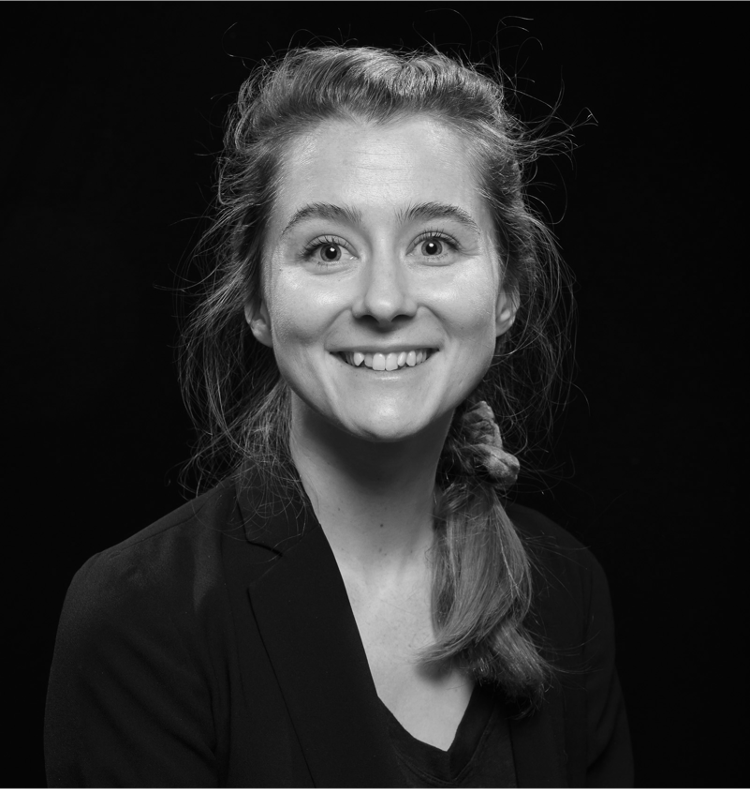
Amy LaViers
Amy LaViers (PhD Georgia Tech and CMA Laban/Bartenieff Institute of Movement Studies) is director of the Robotics, Automation, and Dance (RAD) Lab, a non-profit based in Philadelphia. The RAD Lab is an organization for art-making, commercialization, education, outreach, and research at the intersection of robotics and dance. Since its founding in 2013, the RAD Lab has employed over 40 people, spawned three start up companies, and received funding from the National Science Foundation, DARPA, industrial partners, and several university-based institutions.
Amy’s work has appeared in print in venues including Nature, Robotics and Autonomous Systems, IEEE Robotics and Automation Magazine, and the Oxford University Press along with live presentations at Georgia Tech, Berkeley, Brown, Princeton, CODAME, and the DanceNOW Festival at Joe’s Pub at the Public Theater. She is co-author of a manuscript, "Making Meaning with Machines", under contract at MIT Press.
This installation presents “Time Enough,” Allison Costa’s Post-Baccalaureate creative research project studying our perception and experience of time through dance and technology. Composed of 10 smaller-scale experiments or “clocks,” each exploring a different element of Allison’s research, the installation will use immersive and interactive projection to lead participants in a reflection on time.
Allison's "Time Enough" Installation will be open Monday through Friday 12:00pm-5:00pm from August 30th until September 10th, 2021. Please stop by!

Bio:
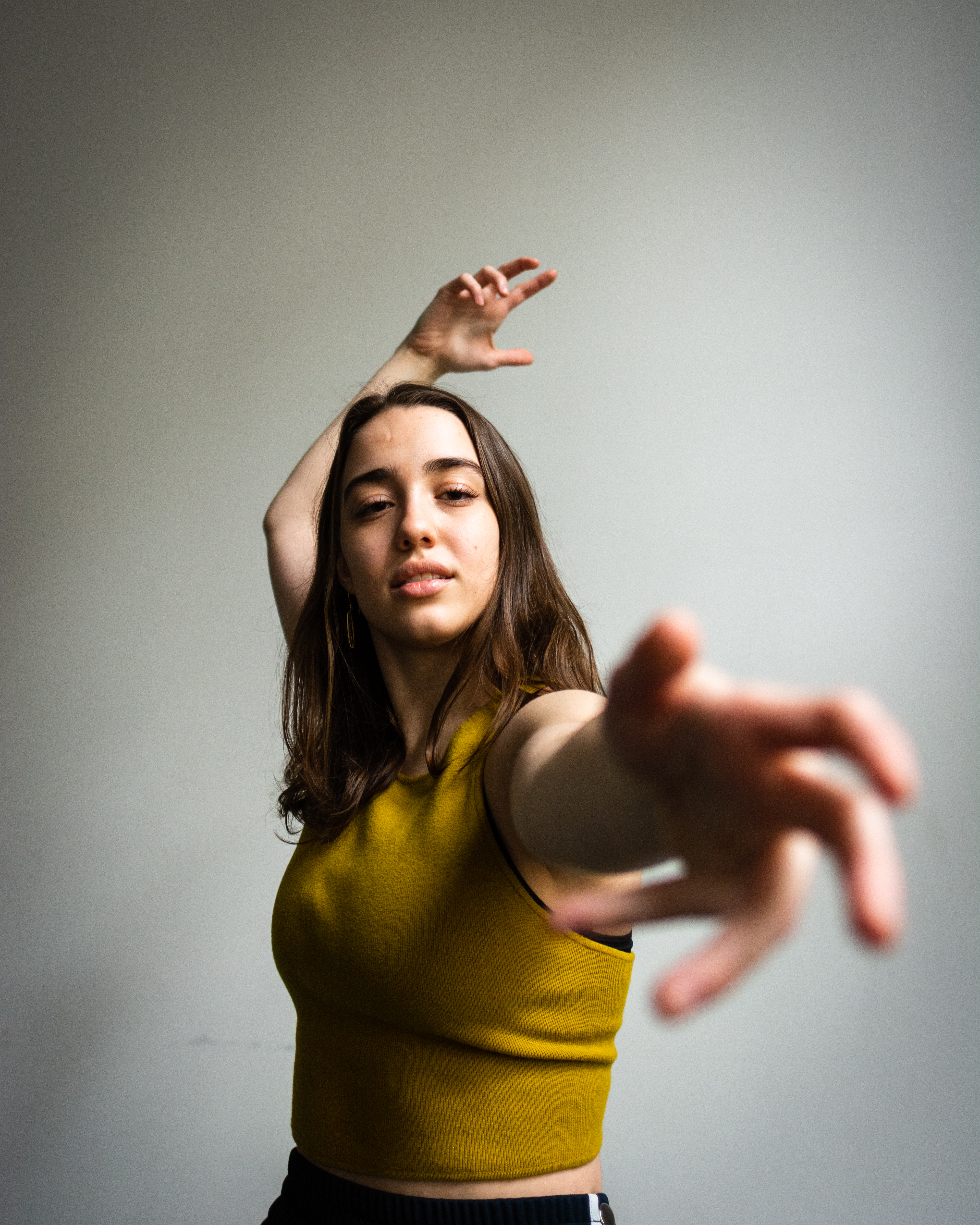
Allison Costa (she/they) (BC’ 19, Dance and Computer Science) is a New York City based dancer, poet, burgeoning choreographer and computer scientist focusing on human-computer interaction.
Fascinated with finding ways to visualize the intangible, she is experimenting with using technology to expand our understanding of human movement potential, as well as using graphics and dance to physicalize data; the immaterial information “stored” in computers. In Spring 2019 she investigated inherent movement inclinations in dancers as a Student Artist in Residence at the Movement Lab. Specifically, she examined improvisation and how, if given feedback via technology, a dancer can adjust their movement to minimize redundancy and expand their range. She hopes to unite the two universal languages of dance and technology to engage a larger audience and breakdown the gap between these two symbiotic fields. For more information go to https://allisoncosta.com/
POSTPONED! Given the uncertainty in the coming weeks around the outbreak of COVID-19 (Coronavirus), we have decided to postpone this long table discussion, especially in light of Barnard/Columbia's class cancelation. Please note this decision was made out of an abundance of caution, and there are no confirmed cases of COVID-19 on campus at this time. We hope to reschedule the event and will be in touch with details as they become available. Thank you for your interest and please direct any questions to movement@barnard.edu.
In a world of endless screens, constant communication and virtual realities, what does it mean to be present? What is virtual, what behaviors do we allow algorithms to dictate, and how do these behaviors impact how we relate to one another?

Join the Movement Lab's Graduate Assistant, Georgia Michalovic, on Monday March 9th 6:00-8:00pm for this Long Table discussion about how presence functions in our world, as it becomes more and more virtual. Open to the public and with no registration required.
POSTPONED! Given the uncertainty in the coming weeks around the outbreak of COVID-19 (Coronavirus), we have decided to postpone this installation, especially in light of Barnard/Columbia's class cancelation. Please note this decision was made out of an abundance of caution, and there are no confirmed cases of COVID-19 on campus at this time. We hope to reschedule the event and will be in touch with details as they become available. Thank you for your interest and please direct any questions to movement@barnard.edu.
Come to the lab for an installation of breath and motion activated robotic wings from Kate Ladenheim and Amy LaVier's work-in-progress, Babyface, a performance that explores how the interaction of bodies and machines can sharpen and/or subvert expressions of identity, specifically expressions of gender.
This installation is from 11:00-5:00pm on March 12th and will be followed by our monthly MeMoSa where Kate and Amy will share and welcome feedback on Babyface and on the experiences of anyone who has tried out the installed wings throughout the day, so make sure to stop by!
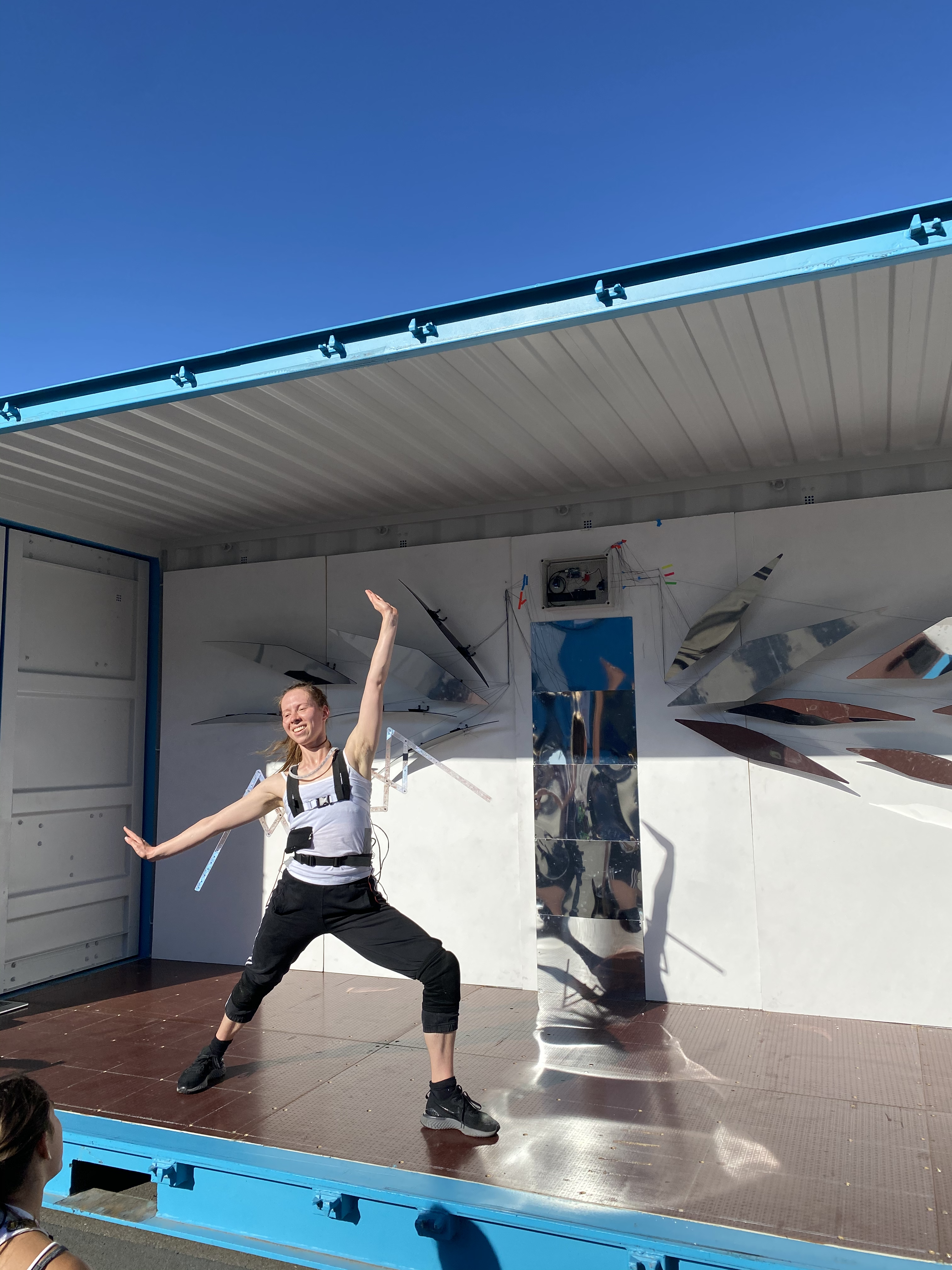
On February 10, 2020 from 11am-6pm the Milstein Center Movement Lab (LL020) hosted a multimedia experience of words, sounds and images celebrating Ntozake Shange's works and influences.
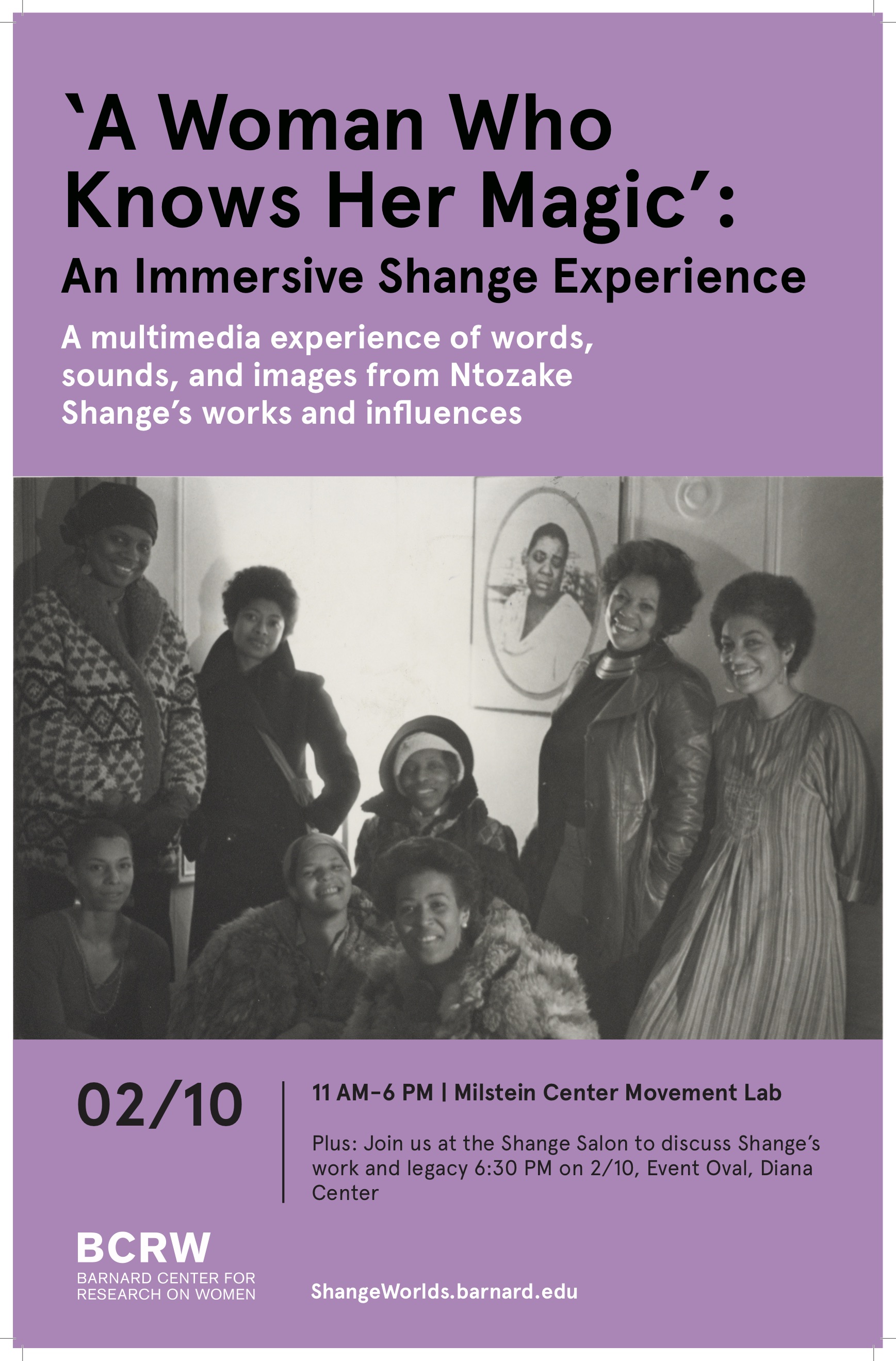
This event was followed by a discussion entitled "'Creation Is Everything You Do': Ntozake Shange, The Sisterhood, and Black Collectivity" in the Diana Event Oval at 6:30pm about Shange's role in the Black woman's literary group that revolutionized literature, publishing, and theater in the 1970s and 80s.
On October 25th, Artist-in-Residence Cari Ann Shim Sham's student's from NYU shared interactive installations with the Movement Lab during the monthly Motion Release.
Featuring a Lonely Disco by Kiara Narvaez, Durational Performance by Luca Renzi, Interactive Overhead Projection by Ori Flomin, and a Live Feed Camera Light Loop by Cari Ann Shim Sham.
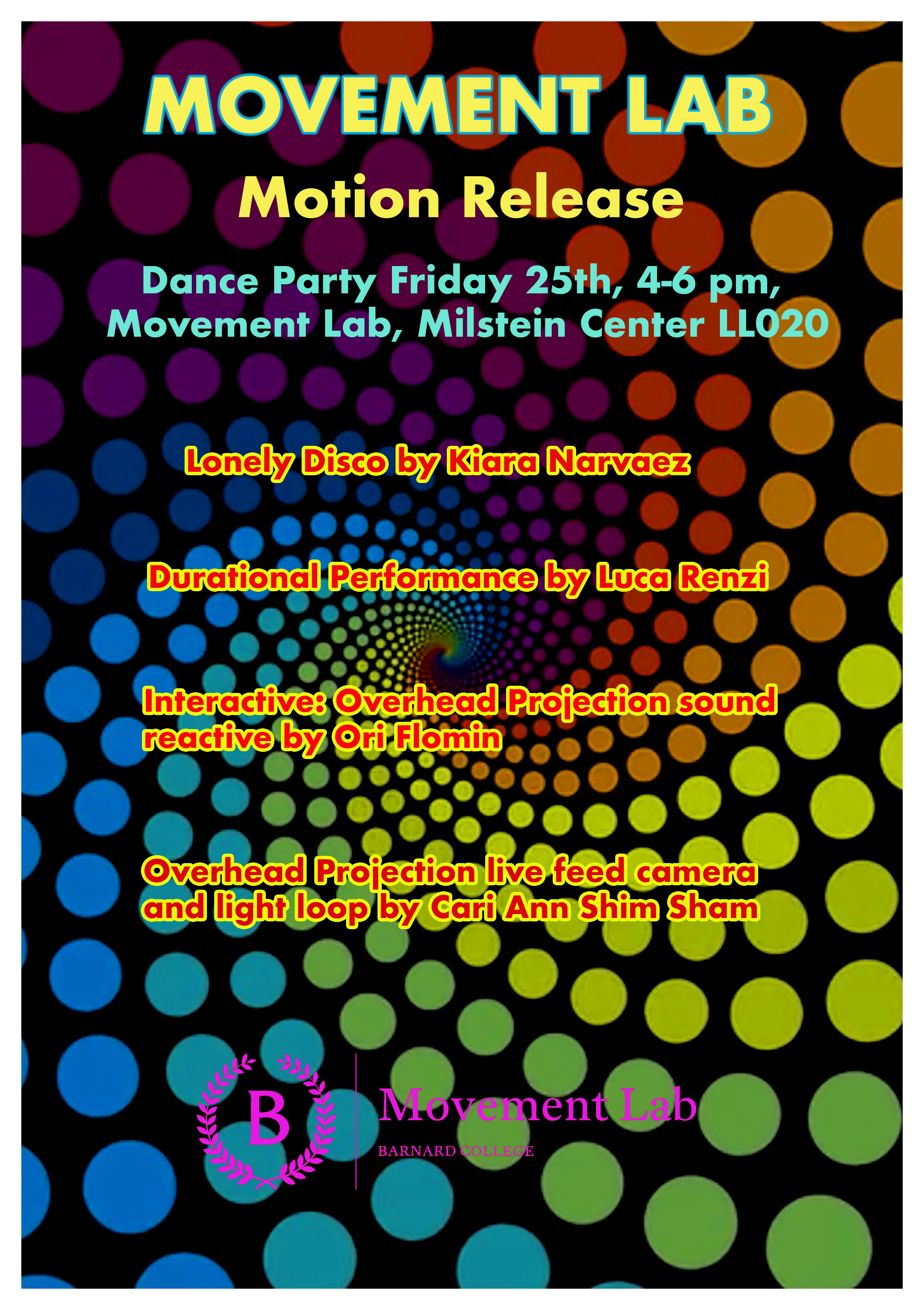
On May 3rd, Professor Mimi Yin's Coding Choreography class, conducted as a joint Barnard College - NYU ITP program, presented work explored throughout the semester in a final showing of choreographic/computer interactive performance.
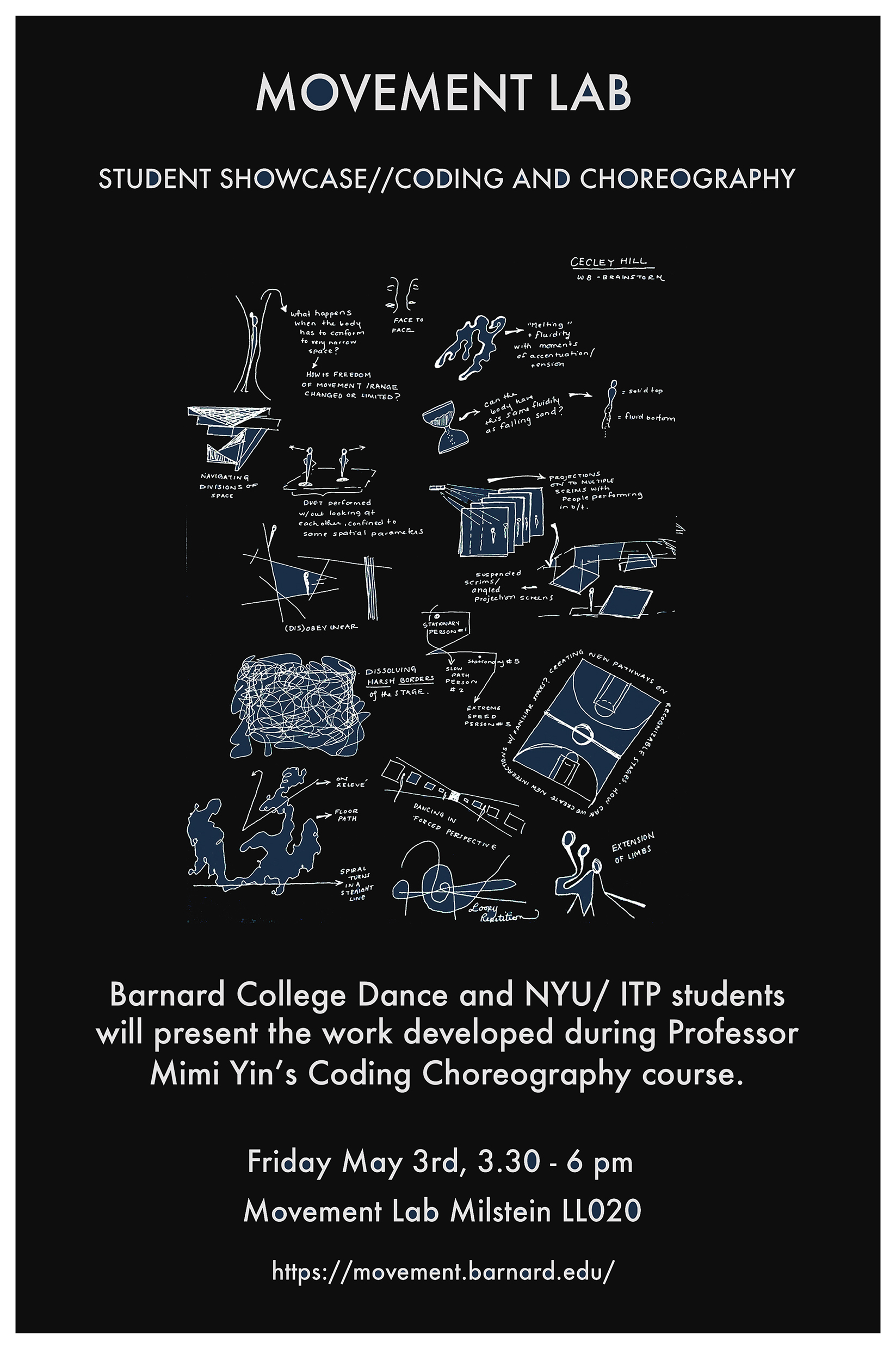
The class was broken into groups, each consisting of two Barnard/Columbia students and two NYU ITP students, resulting in 5 roughly 20 minute long performance installations. The showing on the 3rd is the second of two performances of these works, the first taking place at NYU the week before. Having to adapt the pieces from the NYU performance space to the Movement Lab and navigating the intricacies of each space is a part of what the Coding Choreography class focused on and discussed, and thus is an integral element of the installation.
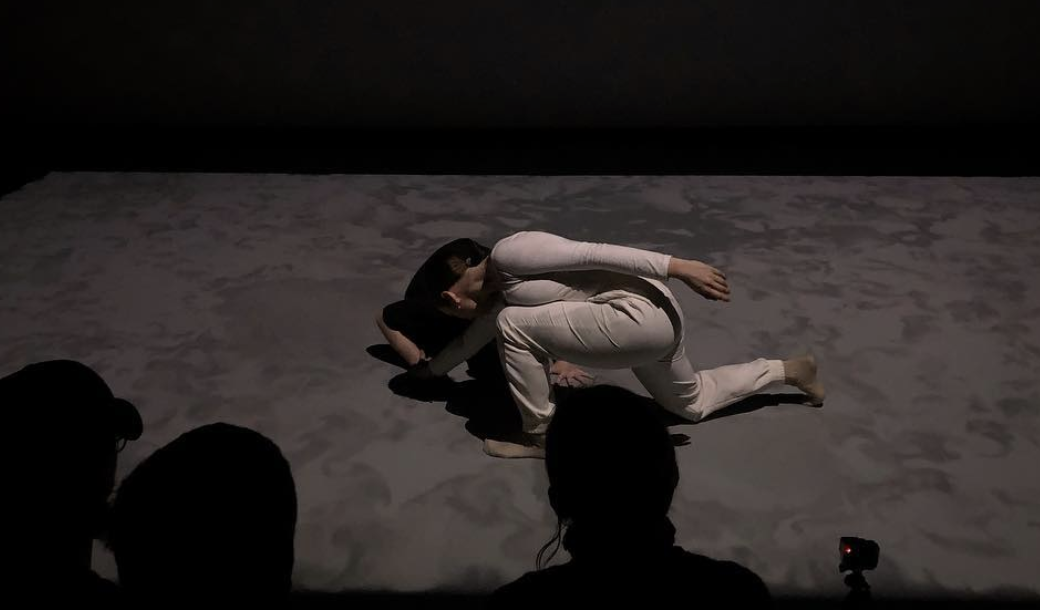
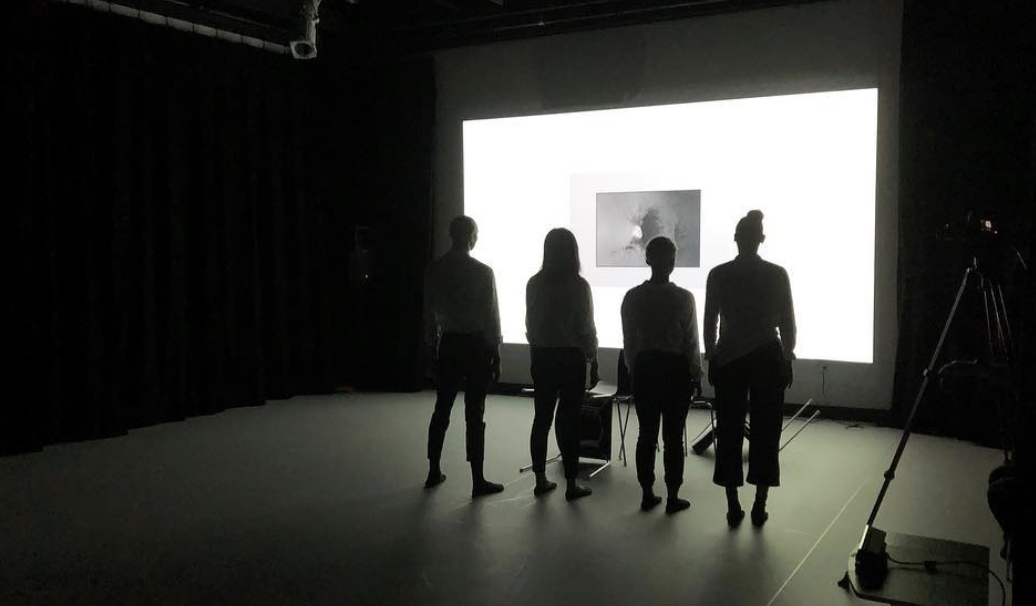
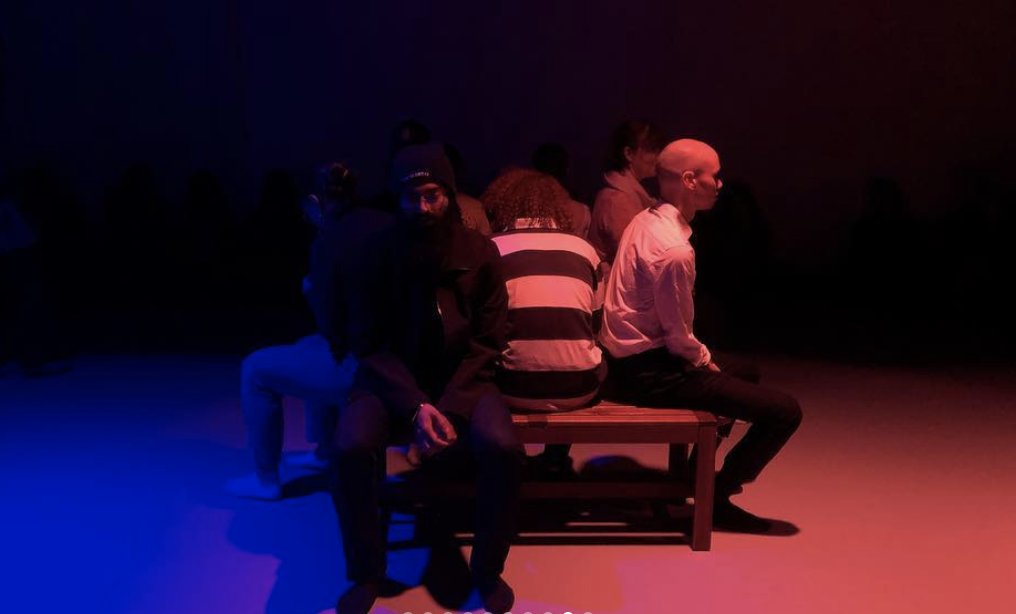
"On March 7th, the Movement Lab became the location for Ratrock’s uniquely interdisciplinary and multi-sensory Winter Featured Artist Show, putting the work of dancers and performers in conversation with painters and architects. The show brought together works by Sarah Courville, Nathan Farrell, Kosta Karakashyan, Gisela Levy, Calvin Hsiao-Sen Yoshiki Liang, Taelor Scott, Miles Zhang, and Anton Zhou....
Walking into the Movement Lab in the lower level of the new Milstein Library felt like entering an alternate universe.... Cushions were piled into two organic, irregular shapes becoming low seats to sit and face the screens and glowing sculpture at the center of the room.... Featured artists’ work was blown up to a massive scale on the lab’s projectors. Since there were multiple screens, the images could be viewed simultaneously side-by-side. Whereas usually the process of looking at art involves isolation - you move from piece to piece, you keep your attention focused exclusively through sight, and the silence of a gallery. At this show, it was almost impossible to resist taking in multiple pieces at a time. ...
The space is equipped with technology that enables creative possibilities: an intensive lighting set-up, for instance, painted visitors’ faces with bright colors. Most visitors migrated and clustered in groups and chatting throughout the show, dying down when one of the multiple live performances began.... All of the elements came together - the music, the bright lights, the space’s physical separation from the academic stress of campus, the act of sitting on the floor barefoot with strangers - and cultivated a sense of otherworldly-ness and gave me an almost childlike joy. Art shows like this are one of the few moments when Columbia students are brought together by something other than schoolwork.
Throughout the night, Kosta Karakashyan, a Ratrock featured artist and the movement lab’s [student] artist-in-residence, both alone and with other student dancers, began to perform short excerpts of choreography from a showcase in the center of the space. His movements often started out subtle - you might miss them if chatting with a friend or looking at the projected paintings. But gradually they gained dynamism and drew the focused attention of all the visitors. The dancers’ casual outfits, blending in with those of the gallery goers, lent an element of spontaneity to the performance.... And given the multimedia nature of the show, it was impossible to fully separate the dance floor from the gallery. The nature of the projections meant that theoretical intersections between different pieces became real and physical - like when Kosta’s body passed in front of one of Sarah Courville’s collages and the piece was projected onto his skin. Putting these analytic images of human bodies next to Kosta’s living, breathing, sweating works of art demonstrated just how many different ways art can tackle the same subjects."
Text written by Zoe Sottile, thanks to Ratrock Magazine
To mark our Grand Opening, Keira Heu-jwyn Chang (aka SpatialK) brought her interactive installation Ball Pit, a responsive video projection to inspire PLAY and CURIOSITY about interactive performance technology in the dance community and to inspire movement in everyone. The animation responded to the user’s movement as you travel through the space. The bigger the movement, the bigger the reaction.
Milstein Grand Opening Movement Lab from Barnard ScreenDance on Vimeo.